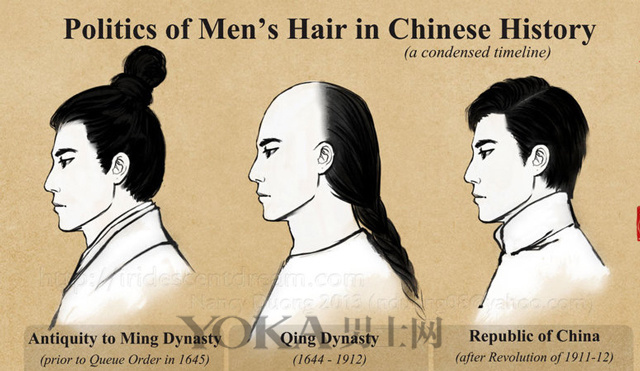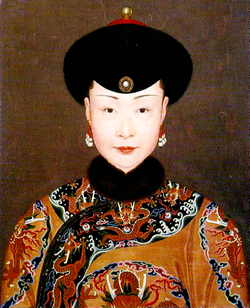Chinese Hairstyles Through the Dynasties
Youtube Channel Off the Great Wall
access date : 28th August 2016
While this video is not a 100% accurate historical documentation, it gives an idea of how important hairstyle is in Chinese history.
Hair carries significant meaning in Chinese culture, it reflects your identity, status, your religions, and your political stands. With changing of ruling parties, the hairstyle changes as well. For example, when Qing dynasty(1644-1912) took over Ming dynasty(1368-1644), The emperor of Qing enforced the policy of cutting hair.

Source from DNA.Yoka
http://www.yoka.com/dna/d/328/556.html
Last access 28th August 2016
It was so important the policy stated “Keep your hair and lose your head, keep your head and lose your hair”.
As for women, it is said that only married women are supposed to bun all the hair up. For single ladies they are supposed to let some hair down.
Also, cutting hair could be an offense in Chinese Culture, as people believed that your body are all the gifts from your parents, damaging your body equals to insulting your parents, which is unfilial. Cutting of hair can be seen as a punishment or humiliation.
There was a historically documented event in Qing Dynasty, between Queen Consort Ulanara乌喇那拉氏 and Emperor Qianlong 乾隆皇帝(1711-1799), during 1765. Ulanara was the sencond Queen Consort of Emperor Qianlong, after the first 孝贤纯皇后Queen Consort Xiaoxianchun(Emperess Xiaoxianchun) passed away.

Imperial Painter-The Palace Museum
Mid 18h Century
Source: https://zh.wikipedia.org/wiki/%E6%B8%85%E9%AB%98%E5%AE%97%E7%BB%A7%E7%9A%87%E5%90%8E
last access 28th August
Queen Consort Ulanara protested against Emperor Qianlong on his decision to appoint an Imperial Noble Consort upon a girl(*see more details below). As cutting hair is normally only performed when someone’s parents or spouse pass away, or some important figure passes away, it representing the virtual death of oneself, as to accompany the dead. The protest was so intense that Emperor Qianlong and his Queen Mother(Empress Dowager) abolished Queen Consort Ulanara into the Cold Palace(**see explanations below). Because of this incidence, Queen Consort Ulanara was never treated fairly and respected by Empreror Qianlong. After she passed away in 1766, one year after the incidence, Emperor Qianlong degraded her funeral scale and standard, and banned her from being buried in royal tombs. Even 13 years after the event, Emperor Qianlong still hasn’t forgiven her.
Relevant resource: (In Chinese) start at 19’20”
Youtube Channel CCTV Culture Official (By China Central Television)
20140606 百家讲坛 清十二帝后宫疑案6 乾隆帝爱恨交加的三个女人
Access date: 28th August 2016
As we can see hair and hairstyle have great meaning in Chinese history. Although in modern times, hairstyle is, in most cases, a personal preference, and cutting hair is not a sin or an offence anymore(maybe in some religions), we definitely have more freedom in deciding how long we want our hair to be and how often we want to style it. However, the idea of hair accessories can still bring up some Chinese traditions and stories. Incorporating hair accessories into my jewelry design can be a good direction to look at. Combining what I have mentioned in previous post regarding Chinese wedding customs, hair accessories can also play up and down, for different occasions, for different hairstyles.
*The hierarchies of Emperors wives in Chinese History, Qing Dynasty
There are strict rules regarding the hierarchies of Emperor’s wife in Qing Dynasty. From the highest ranking to the lowest ranking, and the maximum number of persons allowed for each title are listed below: (Translation may vary)
皇后 Queen Consort x 1
皇贵妃 Imperial Noble Consort x 1
贵妃 Noble Consort x 2
妃 Consort x 4
嫔 Dame x 6
贵人 Noble Lady x unlimited
常在 Attendant x unlimited
答应 Repliant x unlimited
Generally, Emperor will respect Queen Consort and do not appoint Imperial Noble Consort as this may make the Queen Consort feel intimidated or threatened, which is why Queen Consort Ulanara was so raged at Emperor Qianlong’s decision.
References:
Translation of titles: http://www.guokr.com/question/482351/ last access 28th August 2016
Hierarchies and number limits: http://zhidao.baidu.com/question/10825806.html last access 28th August 2016
** The Cold Palace:
Also known as Limbo. A representation of the place in the Forbidden City where Emperors put his abandoned, abolished or unwanted wives to spend rest of their life. Usually it means the Emperor has lost interests in them or wants to punish them for their wrong doings.
The Cold Palace is not a specific palace in the Forbidden city, it symbolizes a situation where emperor does not want to pay attention to the wife anymore, and do not entitle the wife to have the welfare that she used to have. This includes less maids servicing her. Once the wife is put into the Cold Palace, it is equals to taking away all her titles in the hierarchy although it may not be officially announced. It is very commonly seen in Chinese drama and novels.
reference:
http://baike.baidu.com/item/%E5%86%B7%E5%AE%AB/33482
last access 28th August 2016
interesting – what jewellery, accessories went with these hairstyles…